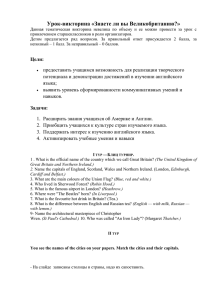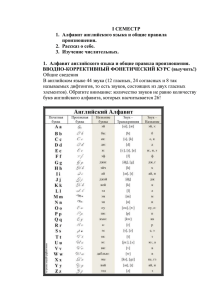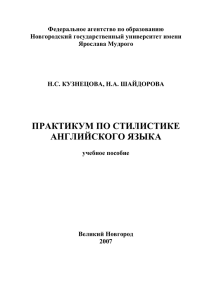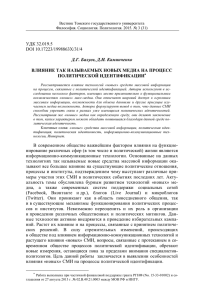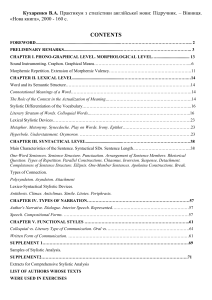IR Galperin
реклама
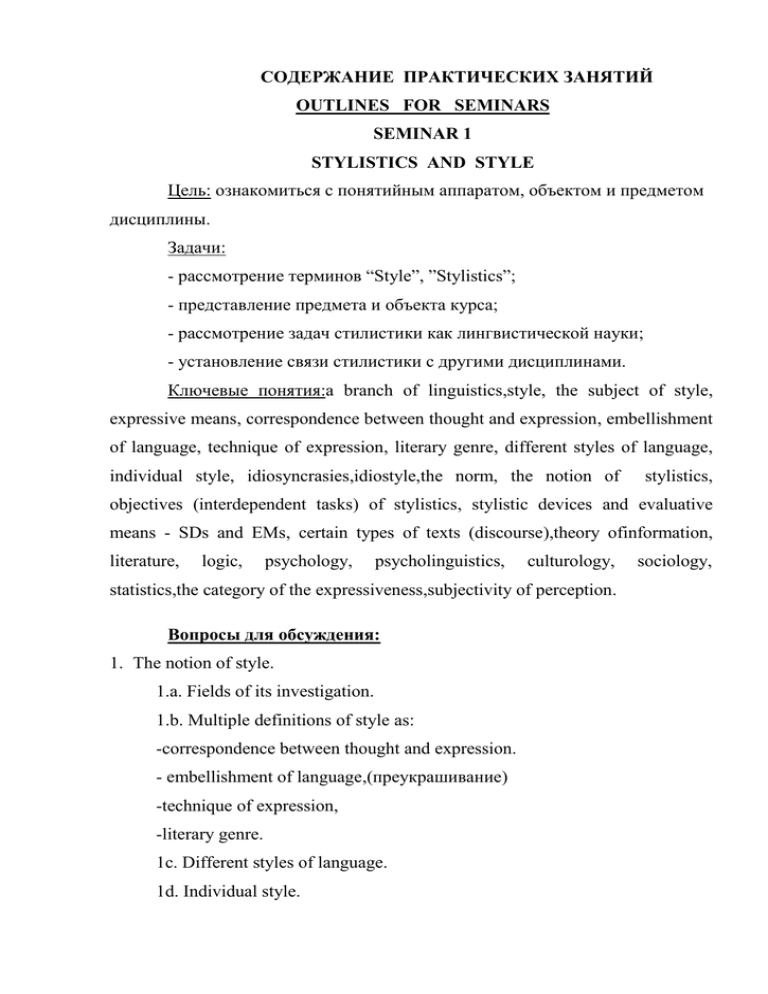
СОДЕРЖАНИЕ ПРАКТИЧЕСКИХ ЗАНЯТИЙ OUTLINES FOR SEMINARS SEMINAR 1 STYLISTICS AND STYLE Цель: ознакомиться с понятийным аппаратом, объектом и предметом дисциплины. Задачи: - рассмотрение терминов “Style”, ”Stylistics”; - представление предмета и объекта курса; - рассмотрение задач стилистики как лингвистической науки; - установление связи стилистики с другими дисциплинами. Ключевые понятия:a branch of linguistics,style, the subject of style, expressive means, correspondence between thought and expression, embellishment of language, technique of expression, literary genre, different styles of language, individual style, idiosyncrasies,idiostyle,the norm, the notion of stylistics, objectives (interdependent tasks) of stylistics, stylistic devices and evaluative means - SDs and EMs, certain types of texts (discourse),theory ofinformation, literature, logic, psychology, psycholinguistics, culturology, statistics,the category of the expressiveness,subjectivity of perception. Вопросы для обсуждения: 1. The notion of style. 1.a. Fields of its investigation. 1.b. Multiple definitions of style as: -correspondence between thought and expression. - embellishment of language,(преукрашивание) -technique of expression, -literary genre. 1c. Different styles of language. 1d. Individual style. sociology, 2. The notion of stylistics. 3. The two objectives of stylistics. 4. The place of stylistics among other language-studying sciences. 5. The chief peculiarities of the discipline. Tips for learning: 1) While getting ready for the seminar, bear in mind the fact that the concept “Style” is broad in its meaning, and it is neither possible to give a unique definition to it, nor innumerate many of them. It is worth while concentrating only on those chief ones that regard style as relation between thought and its manifestation, as an expression technique, as a literary genre, as idiostyle and idiosyncratic language of an author. 2) When it comes to the question about Stylistics,look at views of the two groups of critics - Russian and central European Formalists who made a major influence on the identity and direction of contemporary English language studies of stylistic phenomena. Correspondingly, the definitions of the term vary a lot. 3) While talking on the idiostyle, concider the following authors along with those that you are currently reading: Ch. Dickens, S. Maugham, J.K. Jerome, J. Galsworthy, A.C. Doyle, M. Twain, O.Henry, J. London and others. Prepare a report on the style of your favourite writer of all times. Choose a book in the original to read for pleasure. Be ready to give examples from it during seminars. 4) It is highly recommended to find evidences where Stylistics issues overlap with other studies, as Theory of Information, Literature, Logic, Psychology, Psycholinguistics, Culturology, Sociology, Statistics, Linguistic anthropology, Generative linguistics, Cognitive linguistics, Computational linguistics, Descriptive linguistics, Historical linguistics, Comparative linguistics, Etymology. Литература: Основная 1. I.V. Arnold. Stylistics. Modern English. – Moscow, 2002. 2. Yu. M. Skrebnev. Fundamentals of stylistics. – Moscow, 1994, 2002. Дополнительная 1. I.R. Galperin. Stylistics. – Moscow, 1977. 2. T.А. Знаменская. Стилистика английского языка. М., 2005, 208 с. 3. Интернет-сайты wikipedia.com,www.ling.upenn.edu SEMINAR2 GENERAL NOTES OF FUNCTIONAL STYLES (FSS) AS A FIELD OF STYLISTIC INVESTIGATION. Цель:рассмотреть понятие «функциональный стиль» Задачи: - представление термина «функциональный стиль» как ключевого в данной дисциплине; -рассмотрение разнообразия функциональных стилей, выделение их отличительных особенностей; -рассмотрениепонятия «вариативностьязыка». Ключевыепонятияtypes discourses,literary of standard,function texts,functional of styles of language, communication,belle-lettres, poetry, emotive prose, drama, publicistic literature, scientific prose, official documents, newspaper functional styles, newspaper headlines, brief news items, press reports, advertisements and announcements, varieties of language,the spoken language, the written language. Вопросы для обсуждения: 1. Functional Styles 2. Principles of FS classification 3. Varieties of Language Tips for learning: 1. The question of Functional Styles is one of the most of the most important in the whole course of Stylistics, for functional styles serve as one of the fields or objectives of this literary discipline as a science. 2. Mind that there are plenty more styles and substyles in the language. Though the lecture describes some styles as well as discloses mainly the newspaper substyles, there appears a possibility for you to present more styles and substyles of the English language on the seminar. You will find them in the book by T.A. Znamenskaya. Find examples of the diverse styles from the internet. Read them out in class. 3. The lecture gives some peculiarities of the spoken variety of the language as different from the written variety. It will be possible for you to find and describe more distinctions between the two and prove by your illustrative examples from home reading/reading for pleasure, etc. Литература: Основная 1.T.А. Знаменская. Стилистика английского языка. М., 2005, 208 с. 2. I.V. Arnold. Stylistics.Modern English. – Moscow., 2002. 3. Yu. M. Skrebnev. Fundamentals of stylistics. – Moscow., 1994, 2002. Дополнительная 1. I.R. Galperin. Stylistics. – Moscow, 1977. Интернет-сайты: www.wikipedia.com,www.ling.upenn.edu SEMINAR3. MeaningsofLanguageUnits Цель: ознакомиться со значениями языковых единиц, разграничить лексическое от стилистического значений. Задачи: - рассмотрение всех возможных значений языковых единиц, наглядное их представление; -демонстрация отличий лексического от стилистического значений лингвистического знака; - ознакомление с компонентами прагматического значения. Ключевыепонятия: lexical meaning, grammatical meaning, descriptive, prime/basic/denotational/dictionary/general stylistic/figurative/pragmatic meanings, connotative meaning, relation, meaning, expressive, denotative dynamicuse, connotational emotive, relation, evaluative expressiveness, emotiveness, positive (meliorative, laudatory), negative (pejorative, derogatory) or neutral (indifferent) meanings, pragmatics. Вопросыдляобсуждения: 1. Meanings of Language Units: A General Division 2. Stylistic (Pragmatic) Meaning a) Expressive Meaning b) Emotive Meaning c) Evaluative Meaning 3. Pragmatics as a Branch of Science 4. Denotational and Connotational Meanings 5.The Difference between Semantics and Pragmatics Tips for Learning: 1. Whilepreparingfortheseminar, aspecialattentionshouldbepaidtothepreeminenceofthenotionofstylisticmeaningamon gothercategoriesofStylistics. Besides, investigationsinthisspherearecloselyconnectedwiththetheoryoffunctionalstyles, becauselinguistic means adherence to this or that functional style is reflected in their functional-stylistic component in their absolute stylistic meaning. 2. Thestylisticmeaningofthewordshouldnotbemixedupwiththelexical one, as the latter is broader and more complex, which includes the stylistic meaning in its structure. 3. Whenpreparingforthequestionaboutthestylisticconnotationalmeaning, you should appeal to some aspects of theory of communication. Additionalinformationisoptional and is realized in the connotative meaning of the word, which serves as an addition to Thementionedaboveinformationcontainstheemotive, the denotative meaning. theexpressiveandtheevaluativecomponents and depends on the speakers/literary character/author’s social status, age group, subjective peculiarities of the message sender or other situational factors of the communication. 4. All possible meanings of the word should be presented schematically at the seminar as it enhances understanding of meaning as a phenomenon. Литература: Основная 3. I.V. Arnold. Stylistics. Modern English. – Moscow., 2002. 4. Yu. M. Skrebnev. Fundamentals of stylistics. – Moscow., 1994, 2002. Дополнительная 2. I.R. Galperin. Stylistics. – Moscow, 1977. 3. T.А. Знаменская. Стилистика английского языка. М., 2005, 208 с. 4. Кобозева И.М. Лингвистическая семантика, М., 2009 5. Интернет-сайты:wikipedia.com,www.ling.upenn.edu SEMINAR 4. Expressive Means and Stylistic Devices Цель: ознакомиться сразличными терминами, представляющими стилистически маркированные единицы языка и речи, представить разницу между выразительными средствами и стилистическими приемами. Задачи: - рассмотрение всех возможных терминов для обозначения маркированных стилистически единиц языка и речи в отечественной и зарубежной литературе по представленной проблеме; -демонстрация отличий между выразительными стилистическими приемами; - трактовка обобщающего термина «фигуры речи». Ключевыепонятия: средствами и stylistic means, stylistic markers, stylistic devices, tropes, figures of speech expressive means (EMs) and stylistic devices (SDs), phonetic, morphological EMs, word-building means, lexical EMs, phraseological units, a rhetorical, elocution,schemes, tropes. Вопросыдляобсуждения: I.General view on SDs and EMs 1. Expressive Means 2. Stylistic Devices II.General view on Figures of Speech Tips for Learning: 1. Some linguists among them Yu.M. Skrebnev considers that expressive means of language constitute the subject of stylistics only partially. Having an option to the force of form rather than that of logic, they are employed in spheres of speech that aim to impress: poetry, fiction, oratory, colloquial speech, but hardly ever science, technology, business letters. In his opinion it would be wrong to confine the aims of stylistics to the investigating expressive means only. Style is regarded as a system of special stylistic devices except that we do not know as yet what these devices are. Stylistic perception is formed in people's minds not only by "special devices", but also by certain minor features, not conspicuous by themselves, but collectively affecting the stylistic quality of the text. 2. Working on the seminar you should also pay attention to plurality of terms suggested by Western and former Soviet scholars. As I.R. Galperin’s approach is taken into consideration in this course, your special concentration should be given to the terms of Expressive Means and Stylistic Device. Distinguishing between the two seems not an easy matter. 3. The main constituting feature of a SD is binary opposition of two meanings of the employed unit, one of which is normatively fixed in the language and does not depend upon context, while the other one originates within certain context and is contextual. 4. Be able to speak on the problem of the norm in language. Provide five examples of SDs and EMs from Russian lyrics and five of those from English. Be ready to quote them, state the SD, and give the idea implied in them. Литература: Основная 1. I.V. Arnold. Stylistics. Modern English. – Moscow., 2002. 2. Yu. M. Skrebnev. Fundamentals of stylistics. – Moscow., 1994, 2002. Дополнительная 1. I.R. Galperin. Stylistics. – Moscow, 1977. 2. T.А. Знаменская. Стилистика английского языка. М., 2005, 208 с. 3. Интернет-сайты wikipedia.com,www.ling.upenn.edu SEMINAR 5 Acknowledged Classifications of Linguistic Expressive Resources Цель: ознакомиться сразличными классификациями выразительных средств языка и речи, представленными как отечественными и западными лингвистами, так и разными эпохами. Задачи: - рассмотрение основных античных классификаций стилистически маркированных языковых и речевых единиц как необходимой основы для дальнейшего их изучения и толкования другими учеными более поздних эпох; - рассмотрение ряда современных классификаций отечественных и западных лингвистов; - сравнение современных классификаций выразительных средств. Ключевыепонятия:Early Trasimachus’Classification, Roman Antique Rhetoric, Gorgius and a colon in rhetoric, Hellenistic Roman Rhetoric System, Aristotle’s Classification, tropes, figures of speech that create rhythm, types of speech,G. Leech’s Classification, I.R. Galperin’s Classification, Y.M. Skrebnev’s Classification, G. Williams’ Classification. Вопросыдляобсуждения: I. Ancient classifications 1. Early Roman Antique Rhetoric 2. Hellenistic Roman Rhetoric System II. Modern Classifications 1. G. Leech’s Classification Of Expressive Means 2. I.R. Galperin’s Classification 3. Y.M. Screbnev’s Classification 4. G. Williams’ Classification TipsforLearning: 1. While pгeparingfortheseminar, youshouldkeepinmindthattherearelotsofexpressivemeansclassifications. StephenUllman (“LanguageandStyle”) thinks that Stylistics is a linguistic discipline, thus it has 3 levels of linguistic analysis: lexical, phonetic, syntactic. The difference of Stylistics from Linguistics is in studying not the language items proper but their expressive tendencies. 2. Dealingwithmodernclassificationsitwillbenecessarytofindmore of them not presented in the lecture, but nonetheless important. For instance, UrveLechtsaalu’s who introduces a lexical group (poetic words, archaisms and dialect words, neologisms); phonetic group (rhythm, euphonia); grammar group (inversion, elliptical sentences, repetitions, exclamations). 3. After regarding all presented classifications of expressive means of the language, be able to present your preferences. Литература: Основная 3. I.V. Arnold. Stylistics. Modern English. – Moscow., 2002. 4. Yu. M. Skrebnev. Fundamentals of stylistics. – Moscow., 1994, 2002. Дополнительная 4. I.R. Galperin. Stylistics. – Moscow, 1977. 5. T.А. Знаменская. Стилистика английского языка. М., 2005, 208 с. 6. Интернет-сайты wikipedia.com,www.ling.upenn.edu SEMINAR 6 Phonetic Expressive Means and Stylistic Devices Цель: ознакомиться сосновными фонетическими приемами в английском языке. Задачи: - рассмотрение основных фонетических выразительных средств и слитистических приемов; - рассмотрение функции фонетических стилистических приемов на ряде примеров из литературы. - изучение этимологии фонетических стилистических приемов в английском языке. Ключевыепонятия:the theory of sound symbolism, onomatopoea, alliteration, assonance, euphony, paronomasia, rhyme, rhythm, the repetition of soundsstressed and unstressed syllables variation, variations in pitch, variation in loudness, variations in speed, pause variations, variations in rhythmicality. Вопросыдляобсуждения: 1.General Notes on Phonetic SDs. 2.Phonetic SDs Proper A) Onomatopoea B) Alliteration C) Assonance D) Euphony E) Paronomasia TipsforLearning: 1. Duringthepreparationfortheseminaritisworthwhileexaminingthenotionofsoundsymb olism, whichwasfirstdescribedbySocrates, ThelattertriedtocombineStylistics and then Psychology by in Charles Bailey. his works. Human’ssensationswhilepronouncingdiversesoundsand perception of the articulation are at the basis of this theory. Baileyconsideredthat, for example, when pronouncing bilabial sounds [p], [b], [f] the speaker blows his/her cheeks out, which symbolizes expressive, emotional perception of the words uttered. 2. Pier Maruzo dealt chiefly with vowels. The scholar thought that sounds [e], [i] are light ad elevated, albeit [o:] is a low and weighty sound. DeLaski (aCanadianStylist), studiedDickens’ literary creativity, analyzed names and family names of the main characters from the point of view of the way they are pronounced. Positivecharacters’ namescontained “light” sounds, negative ones – “dark” sounds. 2. Itshouldbealsotaken into consideration that in all manifestations of sound symbolism we have to do with hidden expressiveness, which becomes obviousin a flow of speech under good circumstances. Thus, itcanbeeitherrevealedorremainhidden. Itisalsoworthmentioningpotentialconditionswhichareinfluencedbyareader’sm otivationtounderstandapieceofaliterary work. Литература: Основная 1. I.V. Arnold. Stylistics. Modern English. – Moscow, 2002. 2. Yu. M. Skrebnev. Fundamentals of stylistics. – Moscow, 2002. 3. I.R. Galperin. Stylistics. – Moscow, 1977 Дополнительная 1.T.А. Знаменская.Стилистикаанглийскогоязыка. М., 2005, 208 с. 2.Интернет-сайтыwikipedia.com,www.ling.upenn.edu SEMINAR 7 Prosody as the Basic Formal Theory of English Poetry Цель: ознакомиться с основами английского стихосложения, прочувствовать английский ритм, научиться определять тип рифмы и слога в английской поэзии. Задачи: - толкование и общее описание английской просодии как теории поэзии; - создание представления о темпе, ритме английского предложения в прозе и в поэзии на основе знаний по фонетике английского языка; - рассмотрение терминов “ритм” и ”рифма”; - выявлениефункцийанглийскойрифмы . Ключевыепонятия:Prosody,form and its content, rhythm, metre, number of feet, number of lines, and rhyme, stressed and unstressed syllables, a stresstimedlanguage, trochee and iambus, trisyllabic, dactyl, amphibrach, anapest, spondaicsyllables, pyrrhicsyllables, monometer, dimeter, trimester, tetrameter, pentameter, hexameter, heptameter, sonnet, a limerick, stanza, monostich, couplet, tercet/triplet, quatrain, hexastich, heptastich, octave, complete/exact/full/identical rhymes,incomplete/slant/half/ approximate/imperfect/near/oblique, single (masculine), double (feminine), apocopated, triple rhymes, simple (eye-rhyme)-compound (mosaic), couplets, triple rhymes, cross rhymes, framing/ring rhymes,pleasurable, mnemonic, structural,rhetorical functions of rhyme. Вопросыдляобсуждения: Prosody as a theory of poetry I. Rhythm and its characteristic features. 1. Metre and its types. 2. Number of feet. 3. The Stanza. Number of verse lines. II. Rhyme. 1. Types of rhyme. 2. The functions of rhyme. TipsforLearning: 1. The seminar is a logical continuation of the previous one. In this connection some terms overlap, but lots of new terms are introduced, too. Two crucial notions in English prosody should be distinguished, these are rhythm and rhyme, for English is considered a stress-timedlanguage. Rhythmisanyrepeatedreoccurrenceofelements, for instance, lengthening or shortening of stressed or non-stressed syllables, repetition of images, thoughts, etc. Rhymeis recurrence of identical or similar final sounds or sound combinations in words. 2.Rhythm is more important for a poetical text. Inpoetryrhythmisconnectedwiththemetre, thatis various poetic patterns of stressed and unstressed elements. Rhythmisalsoinherentinprose and has an important function there. The basis of the prosaic rhythm is repetition of diverse elements as well as phonetic ones (parallel constructions, images, ideas, etc.)Rhythmic organization of a text makes the thoughts and emotions of the author clearer to the reader, intensifies the idea of the whole literary work. 3. AGermanlinguistH. Grossbelievesthat “rhythmbearsaself-burden” whichhelpswithahuman’sreaction to the contemporary time, creates an illusion that things which we read about have their own life in their own time. Thus, Rhythm and metre have an expressive function and reinforce the actions of language elements. Литература: Основная 1.I.R. Galperin. Stylistics. – Moscow, 1977. 2.I.V. Arnold. Stylistics.Modern English. – Moscow, 2002. 3.Yu. M. Skrebnev. Fundamentals of stylistics. – Moscow, 1994, 2002. Дополнительная 3.Интернет-сайтыwikipedia.com,www.ling.upenn.edu SEMINAR8. LEXICAL STYLISTIC DEVICES.EMS AND SDS BASED ON SIMILARITY Цель: ознакомление с основными лексическими приемами в английском языке. Задачи: - представить классификацию основных важнейших лексических приемов в английском языке; - рассмотрение лексических стилистических приемов, основанных на первом принципе классификации - уподоблении; - выявлениеих функций в тексте. Ключевыепонятия:simile, comparison, metaphor, metonymy, antonomasia, epithet, genuine, trite (dead)metaphor, simple metaphor, sustained (prolonged), metaphoricalаntonomasia, metonymical аntonomasia, simple, compound, phrase epithets, reversed epithet. Вопросыдляобсуждения: 1.SDs based on similarity of objects 1.1 Simile 1.2 Metaphor 1.3 Metonymy 1.4 Antonomasia 1.5 Epithet TipsforLearning: 1. Mind that all figures of speech based on comparison have one feature and aim in common: to compare one object of reality to another. Yet there are subtle differences between them that make them unique. This is the most commonly used and welcomed category in Modern English, as metaphors, metonymies and similes are presented in every functional style and substyle if one speaks about imagery of the text. 2. Simile and comparison are very close to each other, still there are certain differences you can’t avoid.We should bear in mind that the simile can be easily confused with comparison. Comparison means weighing two objects belonging to one class of things with the purpose of establishing the degree of their sameness or difference. To use a simile is to characterize one object by bringing it into contact with another object belonging to an entirely different class of things. 3. Some scholars regard metonymy as a type of metaphor and don’t single it out. Yet Metonymy is a SD based on a different type of relation between the dictionary and contextual meanings, where a part of a notion substitutes the notion itself. On the other hand, in metaphors objects upon the whole, not parts of them are taken into consideration. 4. There can be one more discrepancy. The question concerns epithets. You shouldn’t mix them up with descriptive attributes. They might look the same, but the meaning, not the structure is all that matters. The epithet is always unexpected, it describes an object as though it is something or someone else, the characteristics of it is not inherent to its real features. Литература: Основная I.V. Arnold. Stylistics.Modern English. – Moscow., 2002. Yu. M. Skrebnev. Fundamentals of stylistics. – Moscow., 1994, 2002. Дополнительная I.R. Galperin. Stylistics. – Moscow, 1977. T.А. Знаменская.Стилистика английского языка. М., 2005, 208 с. Интернет-сайты wikipedia.com,www.ling.upenn.edu SEMINAR9. LEXICAL EMS AND SDS BASED ON CONTRAST Цель: ознакомление с основными лексическими приемами в английском языке, основанных на контрасте. Задачи: - рассмотрение лексических стилистических лексических приемовв английском языке, основанных на втором принципе классификации контрасте; - выявлениеих функций в тексте. Ключевыепонятия:Zeugma, the realization of two meanings.The Pun (Play on words), the interaction of two well-known meanings of a word or phrase, English jokes and riddles.Homographic puns.Heteronymicpuns.Homophonic puns. The compound pun.Extended puns.Oxymoron.Irony.Tragic (or dramatic) irony.Socratic irony.Cosmic irony.Situational irony. Вопросыдляобсуждения: 1. Zeugma 2. ThePun 3. Oxymoron 4. Irony.Types of Irony. TipsforLearning: 1. The question of zeugma, the pun, oxymoron and irony can be regarded not only on the lexical level. Zeugmas and other mentioned figures of speech can be extended to the level of sentences. 2. You should differentiate between zeugma and the pun. In the pun there is no reference to a verb, whereas in zeugma both significant lexemes or parts of a sentence refer to one and the same verb. Use the opportunity to refer to www.punoftheday.com site in search of current English puns. Your mentioning of exquisite examples will benefit your answer at the seminar. 3. Mind that irony can be of different types which vary dramatically. Provide examples of comic irony, tragic irony, situational irony etc. Литература: Основная I.V. Arnold. Stylistics.Modern English. – Moscow., 2002. Yu. M. Skrebnev. Fundamentals of stylistics. – Moscow., 1994, 2002. Дополнительная I.R. Galperin. Stylistics. – Moscow, 1977. T.А. Знаменская.Стилистика английского языка. М., 2005, 208 с. Интернет-сайты wikipedia.com,www.ling.upenn.edu SEMINAR10. LEXICAL EMS AND SDS BASED ON PROXIMITY (NEARNESS) Цель: ознакомление с основными лексическими приемами в английском языке, базирующимися на принципе схожести. Задачи: - рассмотрение лексических стилистических приемов, основанных на третьем принципе классификации - схожести и иносказания; - выявлениеих функций в тексте. Ключевыепонятия:1.Periphrasis (Circumlocution).Euphemism.Hyperbole.Understatement (Litotes).Meosis.Interaction Of Logical And Emotional Meanings. Interjections and exclamatory words.Primary Interjections.Derivative Interjections. Вопросыдляобсуждения: A. Periphrasis (Circumlocution) B. Euphemism C. Hyperbole D. Understatement (Litotes) TipsforLearning: 1. All figures of speech based on nearness have one thing in common: they have their aim at explaining the same denotate in a roundabout manner. You should pay attention to the effect they produce in the final end. Euphemism has a diminutive effect of putting the language points in a milder way not to sound rude. The social functional style circumstances matter a lot for this SD. The Litotes had a direct diminutive effect. 2. Hyperbole has the opposite effect of making linguistic items grotesque. The SD is commonplace in fiction, more often than not having a humorous consequence. 3. Try to find illustrative examples of periphrasis, euphemism, litotes,hyperbole,interjections, exclamatory wordsin the body of the text for your home reading or reading for pleasure book. Be ready to comment on their types and the author’s ideas suggested by them. 4. Classify the picked from the text euphemisms. Dwell on the belonging of those to types of speech. What functional style do they adhere to? 5. Study additional notes to Lecture 10 and find out about some more of emotional SDs, these being interjections and exclamatory words. Dwell on their types and stylistic functions in the text. Литература: Основная I.V. Arnold. Stylistics.Modern English. – Moscow., 2002. Yu. M. Skrebnev. Fundamentals of stylistics. – Moscow., 1994, 2002. Дополнительная I.R. Galperin. Stylistics. – Moscow, 1977. T.А. Знаменская.Стилистика английского языка. М., 2005, 208 с. Интернет-сайты wikipedia.com,www.ling.upenn.edu SEMINAR 11. PECULIAR USE OF SET EXPRESSIONS Цель:ознакомлениес особенностями использования в устном и письменном предъявлении английского языка устойчивых выражений с точки зрения стилистики. Задачи: - разграничение терминов «фразеология» и «идиоматика», «фразеологизм» и «идиома», применяемых при рассмотрении устойчивых выражений в языке; - представить классификацию основных важнейших идиом в английском языке; - выявлениеих функций в тексте на примерах. Ключевыепонятия: cliché.Proverbs and Phraseology.Idiomacity.Phrase.Idiom.The sayings.Paremiology.Paremiography.Epigrams.Poetic epigrams.Non-poetic epigrams.Quotations.Reasons for using quotations.Allusions.Re- evaluation of Idioms.Additions to idioms. Вопросыдляобсуждения: 3. The cliché 4. Proverbs and sayings 5. Epigrams 6. Quotations 7. Allusions 8. Decompositions of Set Phrases TipsforLearning: 1. You should bear in mind that the term phraseology was adopted by Soviet scholars, after a Swiss linguist Chales Bally’s introduction of the term “phraseologie” in the meaning of «a branch of Stylistics dealing with coherent word-combinations. In Western linguistic schools the corresponding term idiomacity is used instead. Nevertheless, the both terms denote the same: a brunch of linguistic study dealing with set expressions/phasemes/idioms. 2. Overused set expressions lose their stylistic value and become clichés. For more information look at www.clichésite.com.Examples of sayings can be drawn out from www.users.tinyonline.co.uk. 3. Stylistics is mostly interested in those set expressions that have been distorted semantically, grammatically etc for special stylistic purposes to produce a certain rhetoric effect on the reader/listener. Литература: Основная I.V. Arnold. Stylistics.Modern English. – Moscow., 2002. Yu. M. Skrebnev. Fundamentals of stylistics. – Moscow., 1994, 2002. Дополнительная I.R. Galperin. Stylistics. – Moscow, 1977. T.А. Знаменская.Стилистика английского языка. М., 2005, 208 с. Интернет-сайты wikipedia.com,www.ling.upenn.edu SEMINAR 12. SYNTACTICAL EMS AND SDS: SYNTACTICAL EMS AND SDS BASED ON THE ARRANGEMENT OF WORDS IN A SENTENCE & SENTENCES IN A PARAGRAPH Цель: ознакомление с основными cинтаксическими приемами в английском языке. Задачи: - представить классификацию основных важнейших синтаксических приемов в английском языке; - рассмотрение синтаксических стилистических приемов, основанных на критерии организации слов в предложении; - выявлениеих функций в тексте; -рассмотрение синтаксических стилистических приемов, основанных на критерии организации предложений в параграфе; - выявлениеих функций в тексте. 1. Ключевыепонятия:Criteria for Syntactical EMs and SDsClassification. Arrangement of words in a sentence & sentences in a paragraph. Abundance of some language elements.Absence of some language elements.Particular ways of linking.Transference of structural meaning.Syntactical EMs and SDsBased on the Arrangement Of Words in a Sentence. Stylistic Inversion. Detached Constructions.3. SDs and EMs Based on Arrangement of Sentences in a Paragraph. Chaotic Enumeration. Gradation(Climax). Suspense. Antithesis. Вопросы для обсуждения: 2. Criteria for Syntactical EMs and SDsClassification 3. Syntactical EMs and SDsBased on the Arrangement Of Words in a Sentence A) Stylistic Inversion B) Detached Constructions 3. SDs and EMs Based on Arrangement of Sentences in a Paragraph A) Chaotic Enumeration B) Gradation(Climax) C) Suspense D) Antithesis TipsforLearning: 1. The direct word-order in the English language Subject-Predicate- Object–the combination which points unmistakably at the subject of the sentence, can be distorted for various stylistic purposes thus having stylistic value. 2. The figures of speech of Gradation, Climax and Suspence can embrace linguistic items larger than a sentence or even a paragraph, i.e. supra syntactical structures and be parts of the text tissue organization. A gradual increase in significance (the Climax) may be maintained in three ways: logical, emotional and quantitative. Литература: Основная I.V. Arnold. Stylistics.Modern English. – Moscow., 2002. Yu. M. Skrebnev. Fundamentals of stylistics. – Moscow., 1994, 2002. Дополнительная I.R. Galperin. Stylistics. – Moscow, 1977. T.А. Знаменская.Стилистика английского языка. М., 2005, 208 с. Интернет-сайты wikipedia.com,www.ling.upenn.edu SEMINAR13. SYNTACTICAL EMSAND SDS BASED ON ABUNDANCE OR ABSENCE OF SOME LANGUAGE ELEMENTS Цель: ознакомление с основными синтаксическими стилистическими приемами в английском языке. Задачи: - рассмотрение синтаксических стилистических приемов, основанных на излишестве языковых элементов в предложении; -выявлениеих функций в тексте; - рассмотрение синтаксических стилистических приемов, основанных на отсутствии некоторых языковых элементов в предложении; - выявлениеих функций в тексте. Ключевыепонятия:Вопросыдляобсуждения:Syntactical Abundance of Some SDs Language Based on Elements. Repetition.Enumeration.Parallelism.Syntactical SDs Based on Absence of Some Language Elements. Ellipsis.Aposiopesis (Break-in-the-narrative).Apokoinu construction. I. Syntactical SDs Based on Abundance of Some Language Elements 1. Repetition 2. Enumeration 3. Parallelism II. Syntactical SDs Based on Absence of Some Language Elements 1. Ellipsis 2. Aposiopesis (Break-in-the-narrative) 3. Apokoinu construction TipsforLearning: 1. Pay attention to versatile range of SDs based on repetition of the different reoccurring elements in a sentence or in a paragraph. They are all targeted at reinforcing the author’s or the speaker’s idea, his/her special attitude to the fact manifested in the language item repetition to make it clear for the reader/listener that the fact is of a very special importance in the whole text. 2. Syntactical SDs Based on Absence of Some Language Elements in a text make the reader think of obvious conclusions for him/herself that can be easily drawn from the context. Литература: Основная I.V. Arnold. Stylistics.Modern English. – Moscow., 2002. Yu. M. Skrebnev. Fundamentals of stylistics. – Moscow., 1994, 2002. Дополнительная I.R. Galperin. Stylistics. – Moscow, 1977. T.А. Знаменская.Стилистика английского языка. М., 2005, 208 с. Интернет-сайты wikipedia.com,www.ling.upenn.edu SEMINAR 14. SYNTACTICAL EMS AND SDS BASED ON PARTICULAR WAYS OF LINKING Цель: ознакомление с основными синтаксическими стилистическими приемами в английском языке, основанными на способах связей между предложениями. Задачи: - рассмотрение основных важнейших синтаксических стилистических приемов в английском языке, основанных на способах связей между предложениями; - выявлениеих функций в тексте. Ключевыепонятия:Asyndeton.Polysyndeton.Gap-Sentence Link.Supralinear semantic analysis. Indicatorsandandbut. Вопросы для обсуждения: 1. Asyndeton 2. Polysyndeton 3. The Gap-Sentence Link TipsforLearning: 4. Syntactical stylistic devices based on particular ways of linking, are characterized by different types of connection between words clauses or sentences.The deliberate omission of conjunctions (Assyndeton) makes sentences almost entirely independent. 5. In enumeration the omission of conjunction andbefore the last word changes the rhythm of the sentence and gives more independence to every word in line. Asyndeton is used as an expressive means when two parts of sentence are joined without any conjunction. It gives energetic effect to the statement; the conjunction is supplied by the reader who is active in interpreting the massage. 6. Polysyndeton, on the other hand,adds the rhythm to the utterance, slows down the statement and makes every word stand out more emphatically due to longer pauses between the words or sentences. Литература: Основная I.V. Arnold. Stylistics.Modern English. – Moscow., 2002. Yu. M. Skrebnev. Fundamentals of stylistics. – Moscow., 1994, 2002. Дополнительная I.R. Galperin. Stylistics. – Moscow, 1977. T.А. Знаменская.Стилистика английского языка. М., 2005, 208 с. Интернет-сайты wikipedia.com,www.ling.upenn.edu SEMINAR 15. SYNTACTICAL EMS AND SDS BASED ON THE TRANSFERENCE OF STRUCTURAL MEANING Цель: ознакомление с основными синтаксическими стилистическими приемами в английском языке, основанными на переносе структурного значения в предложениях. Задачи: - рассмотрение основных важнейших синтаксических стилистических приемов в английском языке, основанных на переносе структурного значения в предложениях; - выявлениеих функций в тексте. Ключевыепонятия:The Transference Of Structural Meaning. The Definition of Rhetorical Questions.Illustrative examples of Rhetorical Questions.Question-inthe-narrative instead of Rhetorical Question.The Definition of Litotes.The Definition of Meiosis.Represented Speech. Вопросыдляобсуждения: 1. Rhetorical Questions 2. Litotes TipsforLearning: 1. Every syntactical structure has its definite function, which is called its structural meaning. When a structure is used in some other function it may be said to assume a new meaning which is similar to lexical transferred one.Among syntactical SDs there are two in which this transference of structural meaning is to be seen: rhetorical questions and litotes. 2. Some syntactical EMs and SDsreflect Stylistic Use of Structural Meaning. Among these are Question-in-the-Narrative and Represented Speech (Uttered and Unuttered One). Литература: Основная I.V. Arnold. Stylistics.Modern English. – Moscow, 2002. Yu. M. Skrebnev. Fundamentals of stylistics. – Moscow, 1994, 2002. Дополнительная ШаховскийВ. И. EnglishStylistics / СтилистикаанглийскогоязыкаИздательство: ЛКИ, 2008 г., 232 C. WalesKatie. A Dictionary of Stylistics, 2nd edition, (Harlow: Longman) 2001 I.R. Galperin. Stylistics. – Moscow, 1977. T.А. Знаменская. Стилистика английского языка. М., 2005, 208 с. Интернет-сайты wikipedia.com,www.ling.upenn.edu SEMINAR 16. OVERVIEW: STYLISTIC FEATURES OF ENGLISH FUNCTIONAL STYLES Цель:обобщающий обзор лексических пластов и функциональных стилей английского языкаи закрепление знаний о стилистических особенностях английского языка. Задачи: - рассмотрение лексических пластов и стилистических функциональных стилей современного английского языка; - дать описательную характеристику различных функциональных стилей для корректного распознавания их в письменном или устном предъявлении. Ключевыепонятия:Stylistically marked layer.Poetic words.Terms words.Archaic groups of words.Literary/bookish Marginal layer.Foreign/loan words.Neologisms.Colloquial layer.Slang.Jargonisms.Dialectal words.Nursery words.Vulgarisms. 2. Distinctive Stylistic Features Of Functional Styles Of English.Literary Colloquial style.Familiar colloquial style.Publicist (media) style.Thestyleofofficialdocuments.Scientific/academicstyle. Вопросы для обсуждения: 1. Stylistically marked groups of words 2. Distinctive Stylistic Features Of Functional Styles Of English TipsforLearning: 1. When getting ready for the first question you should pay attention to archaic words, borrowed words and slangisms as stylistic phenomena. Archaismsaredividedtolinguistic and non-linguistic ones. Linguistic archaisms denote an object or a phenomenon which still exists, but has another name already. Non-linguistic (historical) archaisms are words that denote obsolete objects or phenomena that are anymore.Archaismsusedinauthor'stextare out of use historical or don’t in exist their majority.Theyserveashelperstocreateahistorical background of a text, making the culture of the past more vivid. Borrowed (Loan) wordsareoftenusedbyauthors to create local colorful surrounding. Sometimes loan words are used to identify the nationality of a literary character. Theproblemofslanghasalwaysattractedlinguists, i.e. such issues as the appearance of slang, drawing a border line between slang and other language layers, transfer of slang lexemes to commonly used neutral language.Specific traits of the slang are abundance of synonyms, exclamations which are, in fact, euphemisms. The most important stylistic function of slang words in an author’s text is providing the emotional, more often than not ironical and satirical colouring to the object. Литература: Основная I.V. Arnold. Stylistics.Modern English. – Moscow, 2002. Yu. M. Skrebnev. Fundamentals of stylistics. – Moscow, 1994, 2002. Дополнительная I.R. Galperin. Stylistics. – Moscow, 1977. T.А. Знаменская.Стилистика английского языка. М., 2005, 208 с. Интернет-сайты wikipedia.com,www.ling.upenn.edu СОСТАВ И СОДЕРЖАНИЕ ЗАДАНИЙ, ПРЕДУСМОТРЕНЫХ ДЛЯ РАЗБОРА НА ЗАНЯТИЯХ ASSIGNMENTS FOR STYLISTIC ANAIYSIS When starting analysing a literary piece, try tostick tothe outline for stylistic analysis. Before starting you should find facts about the man-of-letters, his/her main biographical landmarks, characterisation of the epoch, geographical, political, economical issues concerning the work if necessary. Tasks after each prose/poetic work will help you in analysing it. Stylistic Analysis Outline 1. Historical context. A short outline of the author’s work in reference to a certain literary trend. 2. The general characteristics of the text under analysis: - a short summary of the text under analysis; - the main idea of the piece and the general attitudes of the author; - implications from the passage under analysis, and the problems or contradictions the writer inevitably faces. 3. The title: its type, role in the text and connection with the text. 4. The structural-semantic organization of the text (introduction; development of the plot; climax; anticlimax). 5. Characteristics of the typology of the author’s narration. It can be: a). third-person narration ( or auctorial narration); b). character-narration (one of the heroes says “I”); с). the author is an on-looker (narrator isn’t involved in events, but says “I”); d). author-narration (the author and the main character coincide). 6. Characteristics of the compositional speech forms (narration, description, discourse). 7. Evaluationofthetextanalyzed: - the waythe main idea of the piece is being disclosed with the help of stylistic means; -the general attitudes of the author; - whether thelanguagemeansareadequateforthemainaimoftheauthor, - the correlation of the author’s and the characters’ speech or speech portrayaldirect reported, and inner speech; - adherence to or violation of the literary norm; - feelings and emotions stirred by the author in a reader; - aestheticeffectachieved.
